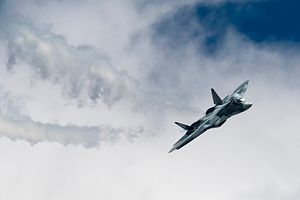The Indian Air Force (IAF) has reportedly withdrawn from one of the most ambitious and controversial joint Indo-Russian defense programs to date: the co-development and production of the Sukhoi/HAL Fifth Generation Fighter Aircraft (FGFA), also known in India as the Perspective Multi-role Fighter (PMF).
Senior Indian officials, including National Security Adviser Ajit Doval and Defense Secretary Sanjay Mitra, purportedly informed a Russian ministerial delegation this month that Indian government was pulling out of the 11-year collaborative program to develop a stealth fighter jet, official sources told IHS Jane’s Defense Weekly on April 20.
Neither the Indian nor Russian governments have so far publicly confirmed New Delhi’s decision to shelve one of the most high-profile joint Indo-Russian defense projects. However, the decision, if confirmed, is unsurprising and has been a long time coming. For the past two years, the IAF has repeatedly stated its desire to withdraw from the program citing disagreements over cost sharing plans, technology transfers, and the aircraft’s technological capabilities, among others (See: “India Wants Out of 5th Generation Fighter Jet Program With Russia”).
One of the IAFs principal concerns included Russia’s failure to develop a next-generation engine for the FGFA to date. Current prototypes of the aircraft are are fitted with a derivative of the Russian-made Saturn AL-41F1S engine, dubbed AL-41F1, an older aircraft engine also installed on the Sukhoi Su-35S Flanker-E. A new engine — the Saturn izdeliye 30 — purportedly capable of mounting 3D thrust vectoring nozzles, is not expected to be ready for serial production until at least 2020.
Another point of contention has been the IAFs insistence on obtaining the capability to upgrade the new fighter jet without Russian support in the future. This would have required Russia to share so-called source codes, sensitive computer codes used to control the aircraft’s various systems (“the key to an aircraft’s electronic brains”) with India. Moscow repeatedly rejected sharing this sensitive data with New Delhi. Russia allegedly eventually agreed to share the computer codes but only if India would up its financial contribution to the joint program to $7 billion, which, however, was rejected by the latter (See: “India, Russia 5th Generation Fighter Jet Deal is Lost”).
The FGFA saga started over 11 years ago, when India and Russia signed an inter-governmental agreement for the joint defense project in 2007, which was followed by the conclusion of a design contract for the co-development of the FGFA/PMF in 2010. However, the program was plagued by disagreements and delays right from the beginning, as I noted elsewhere:
Delays were caused by New Delhi and Moscow disagreeing over many fundamental aspects of the joint development project including work and cost share, aircraft technology, as well as the number of aircraft to be ordered. After evaluating the first PAK FA T-50 [Su-57] prototype (the Russian prototype of the PMF), the [ IAF] wanted more than 40 changes addressing, among other things, perceived weaknesses in the plane’s engine, stealth, and weapon-carrying capabilities.
Both sides also failed to agree on the number of stealth fighters to be produced:
Russia announced in late 2015 that it would only induct a squadron (18-24 aircraft) of PAK FA fighter aircraft, and procure additional Sukhoi Su-35 aircraft instead. The original deal involved Russia procuring 250 and India 144 aircraft at a cost of around $30 billion by 2022. As a result, India threatened to abandon the project in its entirety. Russia in turn made a number of concessions including an offer to cut down its financial contribution from $6 to $ 3.7 billion for three PAK FA T-50 prototypes and substantial technology transfers.
According to IHS Jane’s, India has not ruled out ‘revisiting’ the project at a later stage, or purchase the Russian variant of the PMF, the Su-57, a single seat, twin-engine air superiority/deep air support fighter developed under the PAK-FA fifth-generation fighter program, should it meet IAF requirements. The first two Su-57s are expected to enter service in 2019.































